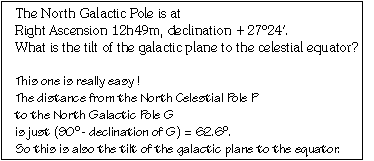
The equatorial system of coordinates (Right Ascension and declination) is the one most often used. But the galactic system is sometimes more useful, e.g. for seeing how objects are distributed with respect to the galactic plane.

In this system, the fundamental great circle is the galactic equator, which is the intersection of the galactic plane with celestial sphere, with corresponding galactic poles. The positions of the poles were fixed by the International Astronomical Union in 1959. We define the North Galactic Pole as that pole in same hemisphere as North Celestial Pole.
To fix the galactic coordinates of object X, draw a great circle between the two galactic poles, passing through X.
The galactic latitude (b) of object X is the angular distance on this circle from galactic equator to X, from - 90° at South Galactic Pole to +90° at North Galactic Pole.
The zero-point for longitude is the centre of galaxy; again, the position was fixed by the IAU. The galactic longitude (l) of object X is the angular distance around the galactic equator from the centre of the galaxy to the great circle through X, measured eastwards 0-360°.
Although later research may come up with better values for the positions of the galactic poles and the centre of the galaxy, the IAU values will still be used to determine this coordinate system.
To convert between galactic and equatorial coordinates, draw the spherical triangle with points at NCP, NGP and X, and apply the sine and cosine rules.

Return to index.